Coronavirus: How artists are depicting the lockdown
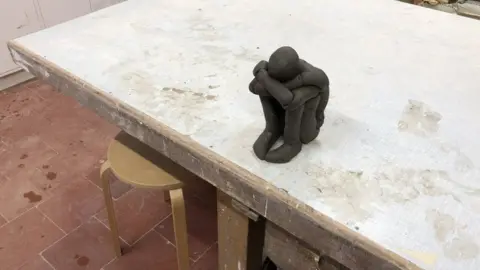 Antony Gormley
Antony GormleyA solitary figure resting its head between tightly wound arms, clasping bent knees and shoulders. Toes curled inwards. As lockdown continues in the UK, British sculptor Sir Antony Gormley, like many artists, is documenting life during the coronavirus pandemic.
"I wanted to make this self-contained body, looking at itself, at the resource that one has within oneself," Gormley, whose work often explores the human body's relationship to space, told BBC News.
"A whole body a bit like a clenched fist, internal and attending to within."
The sculpture - Hold - is a small folded figure in dark clay, made during lockdown and shared online via London's White Cube gallery.
"I suppose that, for me, was trying to make an objective equivalent for the state that we're all in," the artist, best known for creating large-scale sculptures such as the Angel of the North, in Tyne and Wear, said.
"Most of us live our lives in ridiculous obligation to a machine that… is always telling us to do more, have more, go to more places, make more money.
"This is a wonderful time in which those imperatives are loosened.
"And we have to ask ourselves: What do we care about? What do we value? What do we love?"
 Antony Gormley
Antony GormleyThe Covid-19 outbreak has seen sweeping changes across the art world, as galleries have been forced to close their doors to visitors and the cultural calendar of exhibitions and talks has dissipated.
But artists have been swift to adapt to the situation, finding new ways to share work with their audiences online.
Last week, street artist Banksy posted images of his latest work on Instagram - a series of his signature stencilled rats causing mayhem in his bathroom during the lockdown.
And David Hockney opted to share 10 of his most recent works on iPad, from isolation in Normandy.
Damien Hirst, meanwhile, created rainbow art featuring coloured butterfly wings, one his best-known motifs, that can be downloaded and put in windows in tribute to NHS workers.
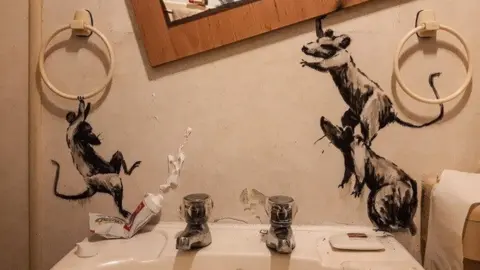 Banksy/PA Media
Banksy/PA MediaEarlier this month, Gormley joined other artists, including Tracey Emin and most recently Sarah Morris, in contributing to a new series of online artist diaries, hosted on White Cube's Instagram account.
"Artists are used to great stretches of time spent working alone, and I think to allow the wider audience to glimpse into their world can be quite uplifting," said the gallery's artistic director Susan May.
Gormley - who usually works in two busy studios in London and Northumberland - felt it was important to represent the "quieter, smaller" aspects of life in his diary, which have come to the fore during the crisis.
"The shelling of peas, the darning of socks, the sort of thing my mum used to do sitting and watching the television... knitting," he explained.
Speaking from his home and workspace in rural Norfolk, the artist noted how he was surrounded by his wife, artist Vicken Parsons, making a hat for their son, Ivo, and daughter, Paloma, seated at the table making a dress for her niece.
The sculptor's seven daily posts also document his first six handmade plates, a progression from the bowls he has been producing since taking an evening pottery course four years ago, alongside the process of making glazes and mending some of his older works.
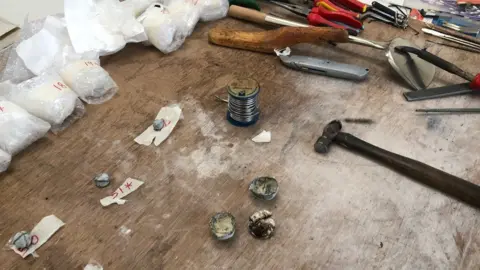 Antony Gormley
Antony Gormley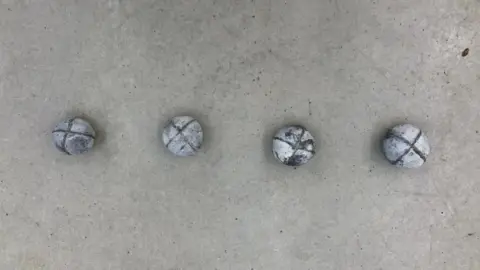 Antony Gormley
Antony GormleyHe has also been experimenting with clay, saying it was an ideal time to play with the material "at a scale more or less on the kitchen table".
"This is a wonderful time because it means that everybody is living the life of an artist, which is essentially making up your day as you want," he said.
"And doing things for yourself or things that seem the right thing to do for you."
There has been a surge of new schemes launched by artists urging people to make art at home and share their lockdown creations online.
Comedian and artist Noel Fielding has started a virtual online art club, with recent themes including "Things we love about Italy", and is sharing his own drawings for inspiration.
Allow Instagram content?

Isolation Art School on Instagram has amassed more than 28,000 followers since it was created in March - with children and adults alike enjoying projects, lessons and tips for best using time in isolation by a fleet of artists.
Among its tutors is Henry Ward, who told how to create "kitchen table" sculptures, inspired by his own works made from found objects.
"In many ways I was ready for the lockdown," the artist, from Peckham, in south London, explained, outlining that much of his practice centres around domestic spaces.
Ward maintains a studio for larger works, but has taken isolation as an opportunity for sustained work on a series of paintings made in his garden shed - with "fruitful" results.
"I think things [in the paintings] are becoming looser and more open, perhaps in odd contrast to our reality of being enclosed and isolated," he said.
 Henry Ward
Henry Ward
Meanwhile, artists from all sectors of the industry are continuing to make and sell work despite the ongoing crisis.
Tens of thousands of artists have backed East Sussex-based painter Matthew Burrow's Artist Support Pledge - where contributors are selling work for £200 and promising to spend the same on another's work once they make £1,000. Scrolling through contributions on Instagram reveals some selling daily drawings made during lockdown.
Allow Instagram content?

And charitable initiatives are benefitting from the vision of artists during the pandemic, such as a British Red Cross campaign which involved 11 artists creating posters to help spread the message that "kindness will keep us together".
Nina Cosford, an illustrator from Hastings, produced a piece for the campaign that celebrates "simple" tokens of kindness during the lockdown, such as phone calls and writing letters.
"We all have ways in which we can help and show kindness," she said.
Allow Instagram content?

Cosford, alongside many other illustrators, has been sharing her representations of lockdown to her 264,000 Instagram followers, aiming to reflect collective concerns and spread positivity during the crisis.
Her style typically light-hearted and whimsical, Cosford said she was initially hesitant about the tone of her posts, until she realised it was "important to maintain the status quo".
"It's a dreadful time, I think one of the best ways to counteract that is through humour," she said.
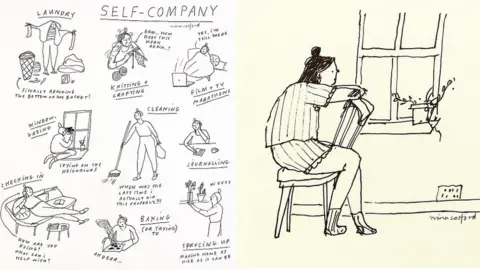 Nina Cosford
Nina Cosford
Sharing content on social media, specifically, also offers an important outlet for creatives to lift people's spirits, said fellow illustrator Octavia Bromell, known as @tinkoutsidethebox on Instagram, from Dorset.
She began creating work as a way of helping her severe anxiety and depression, with her vibrant illustrations aiming to find the joy in everyday life.
Now with 14,000 followers, she said she has gained a vital connection with people across the world.
"I think more people are experiencing a form of distress that feels very familiar to me," she said.
"My work has become an outlet that means I can express some positivity and, hopefully, I can share it with [other] people as well."
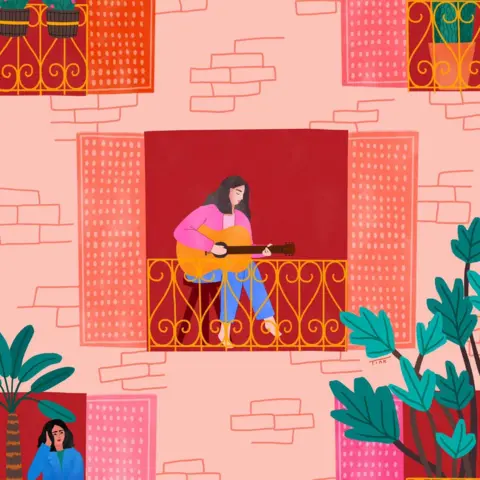 Octavia Bromell
Octavia BromellIndeed, Cosford concluded that the role of artists "to comfort people, unite people and inspire people" was needed now more than ever from the industry.
"I think that's really being acknowledged," she said. "And I hope it will continue to be appreciated after this passes - how vital the arts are in this and how they are day to day, not just in a time of crisis."
All images subject to copyright.
